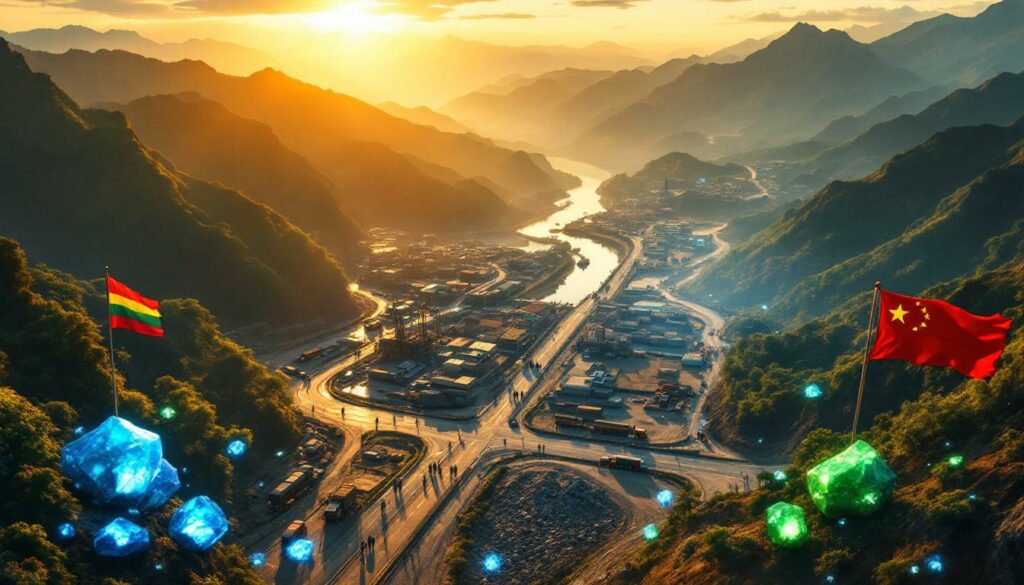How Is Myanmar's Civil Conflict Reshaping Global Heavy Rare Earth Markets?
The Critical Role of Myanmar in Rare Earth Supply Chains
Myanmar has emerged as a crucial player in the global heavy rare earth elements (HREEs) supply chain, contributing approximately 50% of global production. These minerals, extracted primarily from the northern Kachin region, have become essential to modern technology manufacturing and the energy transition security.
According to recent industry reports from Mining Technology, Myanmar's strategic importance in the rare earth market has grown dramatically over the past decade, creating an unexpected vulnerability in global supply chains. The country's unique geological formations contain exceptionally high concentrations of heavy rare earths like dysprosium and terbium—elements that command premium prices due to their irreplaceable properties.
"The concentration of such critical resources in a politically volatile region creates inherent supply vulnerabilities that ripple throughout global technology markets," notes a Reuters report cited by Mining Technology. This concentration is particularly concerning as these resources are located less than 100km from the Chinese border, creating a geographically compact but strategically vital supply corridor.
Unlike light rare earths, which are more abundant globally, Myanmar's heavy rare earth deposits feature exceptional ore grades that make them economically superior to alternative sources, even in more politically stable regions.
Understanding Heavy Rare Earths and Their Applications
Heavy rare earth elements, particularly dysprosium and terbium, play an irreplaceable role in manufacturing permanent magnets used in electric vehicle motors, wind turbine generators, and defense systems. What makes these elements "heavy" is their atomic weight, but what makes them invaluable is their unique ability to maintain magnetic properties at high temperatures.
A single electric vehicle requires between 0.5-1kg of dysprosium in its motor magnets, while a modern wind turbine can contain more than 200kg of various rare earth elements in its components. These quantities may seem small, but the absolute scarcity of these elements makes their supply chain particularly vulnerable to disruption.
The technological limitations preventing substitution create a fundamental dependency that cannot be engineered around with current technology. Despite intensive research into alternatives, no viable substitutes have been developed that can match the performance characteristics of dysprosium-enhanced magnets in high-temperature applications.
Myanmar's ore bodies contain significantly higher concentrations of these critical heavy rare earths compared to alternative sources in Australia, Vietnam, or the United States, making them particularly valuable despite the political risks associated with extraction.
Geopolitical Dynamics Driving the Current Crisis
The Evolution of Myanmar's Political Landscape Since 2021
The February 2021 military coup in Myanmar triggered a cascade of conflicts that continue to reshape control over the country's resource-rich regions. What began as protests against the junta has evolved into sustained armed resistance, with ethnic armed organizations like the Kachin Independence Army (KIA) expanding their territorial control.
The coup shattered a delicate political balance that had allowed mining operations to function under a complex system of informal agreements between the central government, local authorities, and armed groups. As civil conflict intensified, control over resource-rich territories became both a means and an end in the struggle for power.
By mid-2025, the conflict reached a critical juncture as the KIA advanced toward Bhamo, a strategic town controlling key transportation routes between mining areas and the Chinese border. This offensive represented a direct challenge to both the military junta's economic interests and China's supply chain security.
"The struggle for control of Bhamo is fundamentally about who benefits from Kachin's mineral wealth," explained a Mining Technology analysis. "The KIA's advance threatens to redirect resource revenues away from the military regime while potentially disrupting China's access to critical minerals."
The fragmentation of territorial control has created a patchwork of mining operations with varying degrees of formality and oversight. Some mines operate with quasi-legal status under KIA administration, while others continue under military protection or through arrangements with local militia groups.
The China-Myanmar Economic Relationship
China's relationship with Myanmar's rare earth sector represents a classic resource dependency pattern. Chinese companies have invested heavily in Myanmar's mining sector over the past decade, creating integrated supply chains that connect extraction sites in Kachin to processing facilities across the border in Yunnan Province.
This relationship grew particularly important after China implemented stricter environmental regulations on its domestic rare earth industry. The ongoing geopolitical tensions have further complicated this relationship, as China seeks to secure strategic resources amid global competition.
China's leverage in this relationship stems from its near-monopoly on rare earth processing, controlling 85-90% of global capacity. This creates an asymmetric dependency: Myanmar needs Chinese buyers for its raw materials, while China has begun diversifying its supply sources.
"China threatened to stop purchasing minerals from KIA-controlled mines if we take full control of Bhamo," an anonymous KIA official told Reuters, as cited in the Mining Technology report. This ultimatum demonstrates China's willingness to use its market position as a diplomatic weapon.
The relationship mirrors China's approach to rare earth resources in other countries, including Africa and Latin America, where investments in extraction are coupled with processing agreements that maintain Chinese control over the value chain. However, the Myanmar situation is uniquely complicated by the ongoing civil conflict and the strategic importance of the resources involved.
The Battle for Bhamo: A Pivotal Conflict
Strategic Significance of the Border Region
Bhamo's geographical position makes it a critical chokepoint in the rare earth supply chain. Located less than 100km from the Chinese border in Myanmar's Kachin State, the town functions as a crucial transit point for minerals extracted from the surrounding mountains.
The transportation infrastructure converging on Bhamo represents the only viable export route for rare earth concentrates heading to Chinese processing facilities. Alternative routes would require traversing mountainous terrain or conflict zones controlled by rival armed groups, making them economically unfeasible.
"Control of Bhamo would give the KIA unprecedented leverage over rare earth supply routes," notes the Mining Technology analysis. This leverage explains why both the military junta and China have taken such a strong interest in preventing the town from falling under complete KIA control.
Historical trade patterns through this corridor date back centuries, with Bhamo serving as a gateway for commerce between China and upper Myanmar. Today, the ancient trade routes have been repurposed for modern mineral commerce, with trucks replacing caravans but following similar pathways dictated by the mountainous terrain.
The town's strategic value is enhanced by its position at the confluence of the Irrawaddy River and overland routes to China, creating a natural logistics hub that cannot be easily bypassed or replicated elsewhere in the region.
Military and Economic Stakes in the Current Conflict
The KIA's military campaign to secure Bhamo represents a direct challenge to both the Myanmar junta's economic interests and China's supply chain security. Reuters reports indicate that fighting has intensified around the town since early 2025, with both sides committing significant forces to the battle.
"China has offered increased cross-border trade as an incentive for the KIA to abandon its attempts to fully control Bhamo," according to the anonymous KIA official quoted in the report. This offer highlights the economic leverage China maintains over all parties in the conflict.
For the military junta, maintaining control of the Bhamo corridor is essential to preserving one of its few remaining reliable revenue streams. As international sanctions have restricted the regime's access to foreign currency, mineral exports have become increasingly vital to funding its military operations.
Local mining operations have been severely disrupted by the shifting front lines, with production declining by an estimated 30-40% in areas affected by active combat. Some mines continue operating under informal arrangements with whichever armed group controls the surrounding territory, while others have been abandoned as workers flee the conflict.
The economic stakes extend beyond the immediate combatants to include local communities that have become dependent on mining-related income. The conflict has created a complex economic ecosystem where survival often depends on maintaining relationships with multiple armed factions.
China's Strategic Response to Supply Disruption
Diplomatic and Economic Pressure Tactics
China's response to the threat of supply disruption has been multifaceted, combining diplomatic pressure, economic incentives, and the development of alternative supply sources. The ultimatum delivered to the KIA in July 2025 represents the most direct intervention, threatening to completely shut down mineral purchases from KIA-controlled mines if the group takes full control of Bhamo.
According to Mining Technology, when questioned about this ultimatum, a Chinese Foreign Ministry spokesperson stated they were "unaware of specifics" but emphasized that "a ceasefire would benefit China, Myanmar, and citizens on both sides of the border." This carefully worded response reflects China's preference for maintaining plausible deniability while exercising significant influence behind the scenes.
The proposed economic incentives for KIA compliance include promises of "increased cross-border trade" in other commodities, suggesting China is willing to offer alternative revenue streams in exchange for maintaining access to rare earth supplies. This carrot-and-stick approach leverages China's position as the dominant economic partner for all factions in the region.
Historical precedents suggest China is willing to follow through on such threats. In previous disputes with other suppliers, Chinese authorities have demonstrated their willingness to redirect purchasing patterns and impose informal trade restrictions that can devastate local economies dependent on mineral exports.
The effectiveness of China's pressure tactics is enhanced by the KIA's limited options for alternative buyers. The specialized nature of rare earth processing means that China remains the only practical destination for raw materials extracted from Kachin mines.
Diversification Strategies for Mineral Sourcing
While applying pressure on the KIA, China has simultaneously accelerated efforts to diversify its heavy rare earth sources. Mining Technology reports that Chinese miners have increased their presence in Myanmar's Shan State, working with local militia groups to secure access to alternative deposits.
These operations in Shan State represent a strategic hedge against disruption in Kachin. Although the deposits are reportedly smaller and lower-grade than those in Kachin, they provide a supplementary source that could help offset supply shortfalls if the conflict intensifies.
Chinese authorities have also encouraged domestic mining companies to accelerate exploration and development projects in other countries with known heavy rare earth deposits, including Vietnam and Africa. These efforts reflect a longer-term strategy to reduce dependency on any single source region.
The diversification strategy extends to processing technology as well. Chinese researchers have intensified efforts to develop more efficient extraction methods that can economically process lower-grade ores, potentially making previously marginal deposits viable alternatives to Myanmar's high-grade resources.
These parallel approaches—applying pressure to maintain access to Kachin's resources while simultaneously developing alternatives—demonstrate China's sophisticated approach to resource security. Rather than relying on a single strategy, Chinese authorities are pursuing multiple pathways to ensure continued access to these strategic minerals.
Global Market Implications and Supply Chain Vulnerabilities
Technology Sector Exposure to Supply Disruption
The concentration of heavy rare earth supply in Myanmar's conflict zones creates significant vulnerabilities for global technology manufacturers. Industries most exposed to potential shortages include electric vehicles, wind energy, and defense systems—all sectors with strategic importance to national economies and security.
Historical precedent provides a sobering perspective on potential market impacts. When China restricted rare earth exports in 2010-2011 during a diplomatic dispute with Japan, prices for some elements spiked by up to 750%. A similar or greater disruption could occur if Myanmar's supplies were suddenly cut off, particularly for heavy rare earths like dysprosium and terbium where alternatives are scarce.
The technological dependency on these materials creates ripple effects throughout manufacturing supply chains. For example, a shortage of dysprosium would impact production of high-performance magnets, which would in turn constrain manufacturing of electric vehicle motors, wind turbine generators, and numerous defense applications.
According to Mining Technology's analysis, these supply chains typically operate with minimal inventory buffers, meaning disruptions could impact production within weeks rather than months. Many manufacturers lack significant stockpiles of these materials due to their high cost and specialized storage requirements.
The timeline for impact varies by sector, with consumer electronics potentially feeling effects first due to shorter production cycles, while automotive and energy sectors might experience delayed but longer-lasting disruptions as their longer planning horizons provide some initial buffer against shortages.
International Responses to Supply Uncertainty
The threat to Myanmar's rare earth supply has accelerated international efforts to reduce dependency on this vulnerable supply chain. Government policies increasingly focus on developing domestic resources, supporting processing capacity outside China, and investing in recycling technologies.
Several countries with rare earth deposits have fast-tracked development projects that had previously been considered economically marginal. Australia, the United States, and Canada have all implemented policy measures to support domestic rare earth production, though these initiatives face significant challenges in competing with the established Myanmar-China supply chain on cost.
The development of a critical minerals reserve in some countries represents one approach to buffering against supply disruptions. Furthermore, the establishment of a European CRM facility demonstrates how regions are working to secure their own supply chains independent of Asian sources.
Corporate strategies for mitigating supply chain vulnerabilities include long-term purchasing agreements, strategic stockpiling, and investments in recycling technologies. Some manufacturers have begun redesigning products to reduce their dependency on the most vulnerable elements, though complete substitution remains technologically challenging.
Recycling technologies represent a promising but still developing alternative source. Current methods recover less than 1% of rare earths from end-of-life products, but research into more efficient processes has accelerated as supply concerns have grown. Even with technological breakthroughs, recycling alone cannot meet demand in rapidly growing markets like electric vehicles.
The diversification of processing capacity outside China has become a strategic priority for many countries, though building this capacity requires significant investment and faces challenges in competing with China's established cost advantages and technical expertise.
Future Scenarios for Heavy Rare Earth Markets
Potential Pathways to Supply Stabilization
The resolution of Myanmar's rare earth supply crisis could follow several potential pathways, each with different implications for global markets. A negotiated settlement between the KIA and Chinese authorities represents the most stable outcome, potentially allowing continued mineral exports under a new revenue-sharing arrangement.
Military outcomes would have divergent impacts on supply stability. A decisive junta victory would likely maintain the existing supply chain but potentially at the cost of increased international scrutiny and sanctions. Conversely, KIA control of key territories could initially disrupt supplies but might eventually establish new export arrangements if relations with China stabilize.
International diplomatic pressure could influence the conflict's trajectory, particularly if major rare earth consumers like the United States, Japan, and European Union coordinate their approach. However, the effectiveness of such pressure would depend on China's willingness to engage, given its dominant position in the processing chain.
The development of alternative supply sources represents the most sustainable long-term solution but faces significant challenges. Vietnam possesses approximately 15% of global heavy rare earth reserves, while Australia's Mount Weld and similar deposits offer potential alternatives. However, developing these resources would require 5-10 years and significant investment to reach commercial scale.
Processing technology innovations could potentially reduce the strategic importance of Myanmar's resources by making lower-grade deposits elsewhere economically viable. Research into more efficient extraction methods continues in several countries, though breakthroughs capable of fundamentally altering market dynamics remain speculative.
Strategic Implications for Global Technology Development
The Myanmar rare earth crisis highlights fundamental tensions in global technology development pathways, particularly for green energy transitions that depend heavily on these materials. Supply constraints could significantly impact decarbonization timelines if they limit production of electric vehicles or renewable energy systems.
Defense sectors face particular vulnerabilities given their dependence on high-performance components that often require heavy rare earths. This creates national security implications that may drive government intervention in markets through strategic reserves, domestic production mandates, or international agreements to secure supply.
Technological innovation may ultimately provide the most sustainable response through material efficiency improvements, substitution research, and design changes that reduce rare earth intensity. However, these approaches require time for research, development, and implementation at scale.
The reshaping of international trade relationships around critical minerals has already begun, with new strategic partnerships forming to secure supply chains. These arrangements increasingly consider geopolitical alignment alongside traditional economic factors, creating a more fragmented global market.
Long-term sustainability considerations for rare earth supply chains extend beyond immediate geopolitical concerns to include environmental impacts, labor practices, and community benefits. Future supply arrangements will likely face increasing scrutiny on these dimensions, potentially creating additional criteria for market access in environmentally conscious economies.
The acceleration of mining innovation trends will be crucial for developing more sustainable and secure supply chains that can withstand geopolitical disruptions like those seen in Myanmar's military junta and global heavy rare earths supply.
Comprehensive Data: Myanmar's Rare Earth Impact
| Aspect | Data Point | Global Significance |
|---|---|---|
| Production Share | ~50% of heavy rare earths | Critical for high-tech manufacturing |
| Key Elements | Dysprosium, Terbium, Gadolinium | Essential for permanent magnets |
| Export Destination | Primarily China | Feeds global processing monopoly |
| Conflict Impact | Disruption to extraction and transport | Threatens technology supply chains |
| Price Sensitivity | High volatility during supply uncertainty | Affects manufacturing costs globally |
| EV Impact | 0.5-1kg dysprosium per vehicle | Could constrain production scaling |
| Wind Turbine Requirements | 200+ kg rare earths per unit | Potential limitation on renewable deployment |
| Processing Concentration | China controls 85-90% of capacity | Creates bottleneck even with alternative mines |
| Recycling Recovery | <1% of rare earths currently recovered | Limited short-term alternative supply |
| Alternative Development Timeline |
Ready to Spot the Next Major Mineral Discovery?
Discovery Alert's proprietary Discovery IQ model instantly identifies significant ASX mineral discoveries, transforming complex geological data into actionable investment insights for both short-term traders and long-term investors. Explore historic examples of exceptional investment returns from major discoveries on our dedicated discoveries page and begin your 30-day free trial today.




